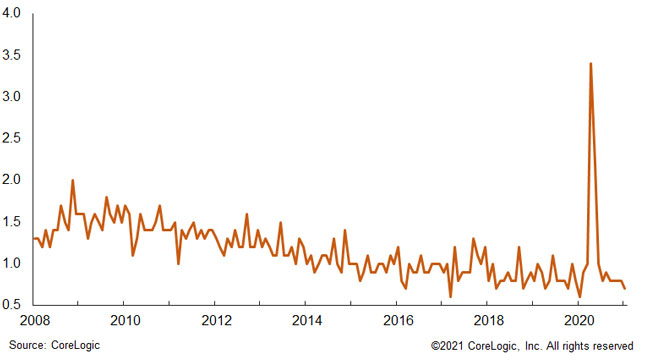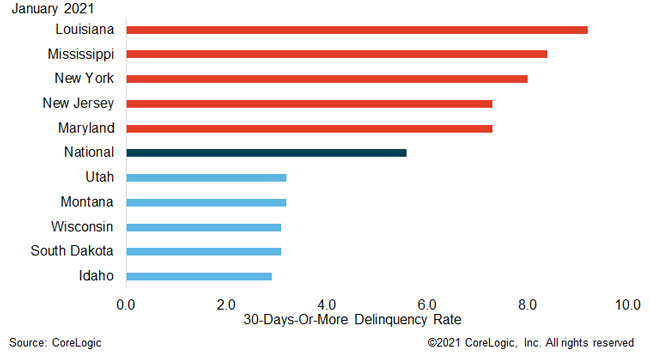
Source: https://www.corelogic.com/blog/2021/4/early-stage-delinquency-rate-lowest-in-over-20-years.aspx
In January 2021, 5.6% of home mortgages were in some stage of delinquency (30 days or more past due, including those in foreclosure)[1], a small decrease from December 2020, and the fifth consecutive monthly decrease. While this is good news, the overall delinquency rate remained high and was 2.1 percentage points above the year ago level, according to the latest CoreLogic Loan Performance Insights Report.
Overall Delinquency Rates
The share of mortgages that were 30 to 59 days past due – considered early-stage delinquencies – was 1.3% in January 2021, down sharply from a post-pandemic high of 4.2% in April 2020 and the lowest rate recorded in at least 22 years.[2] The share of mortgages 60 to 89 days past due was 0.5% in January 2021, down from 0.6% in January 2020 and down from 2.8% in May 2020. The drop in early and mid-stage delinquencies from the spring indicates a lower share of mortgages entering delinquency after the initial surge after the start of the pandemic in the U.S.
The serious delinquency rate – defined as 90 days or more past due, including loans in foreclosure – was 3.8% in January, more than three times that of a year earlier, but down from a recent high of 4.3% in August. The CARES Act provides relief to mortgage holders and has worked to keep delinquencies from progressing to foreclosure and therefore the foreclosure inventory rate – the share of mortgages in some stage of the foreclosure process – remained low at 0.3% in January 2021, down from 0.4% from January 2020. The decrease in the serious delinquency rate from the August high and increases in home equity as prices continued to increase in 2021 lessen the likelihood of a foreclosure wave later in the year when homeowners emerge from forbearance.
Stage of Delinquency: Rate of Transition
In addition to delinquency rates, CoreLogic tracks the rate at which mortgages transition from one stage of delinquency to the next, such as going from current to 30 days past due (Figure 1).

The share of mortgages that transitioned from current to 30 days past due fell to 0.7% in January 2021 – a decrease from the peak of 3.4% in April 2020, and the lowest rate in 12 months. The lower transition rate means that while the rate of mortgages in any stage of delinquency remained elevated, fewer borrowers slipped into delinquency than early in the recession.

State and Metro Level Delinquencies
Figure 2 shows the states with the highest and lowest share of mortgages 30 days or more delinquent. In January 2021, that rate was highest in Louisiana at 9.2% and lowest in Idaho at 2.9%. All U.S. states posted annual gains in their overall delinquency rate in January 2021, and places with large job losses during the last year experienced large increases in delinquencies. Hawaii and Nevada, both of which rely heavily on tourism and the hospitality industry, had the largest 12-month spike in delinquency rates, up 4.2 and 4.1 percentage points respectively. They also had large increases in unemployment rates, up 8.3 percentage points in Hawaii and 4.8 percentage points in Nevada compared with 2.8 percentage points for the U.S.

Figure 3 shows the 30-plus-day past-due rate for January 2021 for 10 large metropolitan areas.[3] Miami had the highest rate at 9.1% and San Francisco had the lowest rate at 3.4%. Miami’s rate increased 4.6 percentage points from a year earlier. Outside of the largest 10, all but three metros recorded an increase in the overall delinquency rate. Oil reliant Odessa, Texas, experienced the largest annual increase with 10 percentage points – the unemployment rate in Odessa increased by 8.2 percentage points in January from a year ealier.
Mortgage delinquencies have been slowing decreasing after peaking in mid- 2020 and the rate of new delinquencies is at a 22-year low, showing that fewer homeowners were falling behind on payments. The ongoing forbearance provisions have kept foreclosure rates low and a recent extension of forbearance will provide time for owners to regain their financial footing as the job market continues to improve. For more housing trends and data, visit the CoreLogic Insights Blog: www.corelogic.com/insights.
© 2021 CoreLogic, Inc. All rights reserved.
[1] Data in this report is provided by TrueStandings Servicing. https://www.corelogic.com/products/truestandings-servicing.aspx. The CARES Act provided forbearance for borrowers with federally backed mortgage loans who were economically impacted by the pandemic. Borrowers in a forbearance program who have missed a mortgage payment are included in the CoreLogic delinquency statistics, even if the loan servicer has not reported the loan as delinquent to credit repositories.
[2] The data in this report date back to January 1999.
[3] Metropolitan areas used in this report are the ten most populous Metropolitan Statistical Areas. The report uses Metropolitan Divisions where available.
To learn more about the data behind this article and what CoreLogic has to offer, visit https://www.corelogic.com/.







Sign up to receive our stories in your inbox.
Data is changing the speed of business. Investors, Corporations, and Governments are buying new, differentiated data to gain visibility make better decisions. Don't fall behind. Let us help.













Sign up to receive our stories in your inbox.
Data is changing the speed of business. Investors, Corporations, and Governments are buying new, differentiated data to gain visibility make better decisions. Don't fall behind. Let us help.





